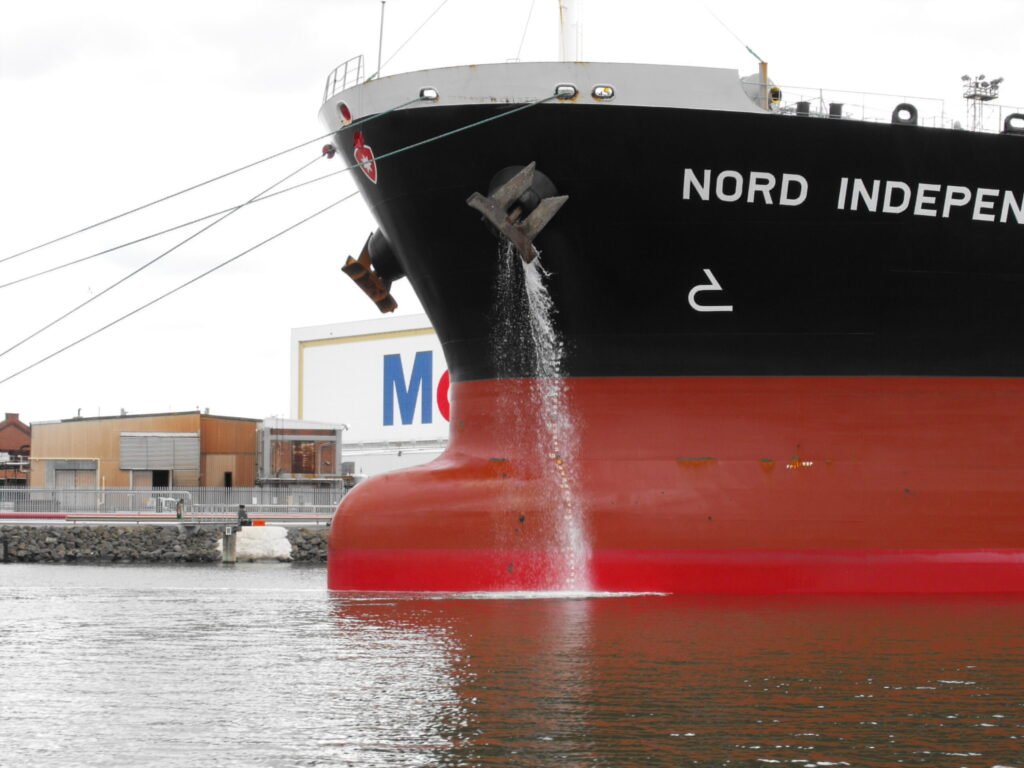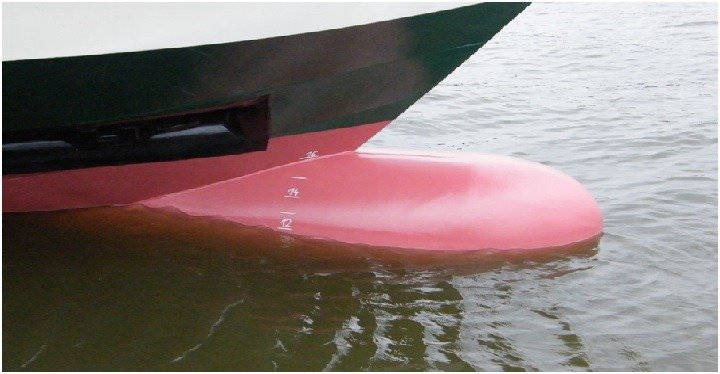Have you noticed that how most of the ships have a strange protrusion at the forward end? It’s a big bulb-shaped lump of metal sticking out below the water and is called a ‘Bulbous Bow’.
The name origin is simple, as this metallic structure normally resembles the shape of a bulb, and is always placed at the bow of the ship. Hence it is called ‘bulbous bow’, and it serves a very specific purpose.
The size of the Bulbous bow is not always same, and varies as per the size of the ship on which they are fitted. Whether the ships are big or small, the bulbous bow are designed to serve one main function.




A bulbous bow is a specialized shape of the front or bow section of a ship’s hull that is designed to reduce drag and increase fuel efficiency. It is a bulb-shaped protrusion that extends below the waterline and is located at the foremost part of the ship. The bulbous bow was first introduced in the 1930s and has since become a common feature in modern ship design.
The main purpose of a bulbous bow is to improve the hydrodynamic performance of a ship by reducing wave-making resistance. As a ship moves through the water, it creates a series of waves at the bow, which can slow the ship down and increase fuel consumption. The bulbous bow helps to reduce the size and strength of these waves, thereby reducing resistance and improving efficiency.
Also Read 10 Different Types of Ship Bow – Explained
Shape of Bulbous Bow
The shape of the bulbous bow is carefully designed to achieve the desired hydrodynamic effect. The bulb is typically located at the waterline, and it is designed to have a smooth, curved shape that gradually tapers towards the main hull of the ship. The size and shape of the bulbous bow depend on a variety of factors, including the size and shape of the ship, the speed and operating conditions of the vessel, and the specific design objectives of the ship.
In addition to reducing wave-making resistance, a bulbous bow can also provide other benefits. For example, it can help to improve the stability and maneuverability of the ship, reduce vibration and noise, and enhance the overall safety and comfort of passengers and crew.
Overall, the bulbous bow is an important feature in modern ship design that can significantly improve the performance and efficiency of a vessel. Its unique shape and design make it a key component of many of the world’s largest and most advanced ships.
Function of Bulbous Bow – Explained
To understand what that function is, let’s first consider a ship without a bulbous bow. As this vessel, moves forward through the water, a pressure wave builds up at the front of the ship. This increases the height of the water, with the ship pushing it ahead, but that water has to go somewhere. What happens is that, the water flows back down the side of the hull, and will keep flowing back down, forming a wave all the way along the side of a hull.
Problem of having a constant wave on the side of the hull is that it increases the drag of the vessel. Thus, resulting in an inconsistent speed of the vessel, thereby increasing the fuel consumption of the vessel. To counter this very problem, bulbous bow comes in picture.
What Is The Bulbous Bow For?
A bulbous bow modifies the way the water flows around the hull, reducing drag and thus increasing speed, range, fuel efficiency, and stability. Ships with bulbous bows generally have twelve to fifteen percent better fuel efficiency than similar vessels without them.
Another function of the bulbous bow is that it increases the buoyancy of the forward part and hence reduces the pitching of the ship to a small degree.
Vessels with high kinetic energy, which is proportional to mass and the square of the velocity, benefit from having a bulbous bow that is designed for their operating speed; this includes vessels with high mass (e.g. supertankers) or a high service speed (e.g. passenger ships, and cargo ships).
Vessels of lower mass (less than 4,000 dwt) and those that operate at slower speeds (less than 12 kts) have a reduced benefit from bulbous bows, because of the eddies that occur in those cases; examples include tugboats, powerboats, sailing vessels, and small yachts.
How does Bulbous Bow work?
When the ship sails forward, it generates a wave system, which can be influenced through the bulb.

In the image we can see the comparison between the wave created by a right bow, the wave created by the bulb and the combination of both.
Meaning, the bulbous bow reduces the wave that enters the hull of the ship.
Most Effective Use of Bulbous Bow
Bulbous bows have been found to be most effective when used on vessels that meet the following conditions:
- The waterline length is longer than about 15 metres (49 ft).
- The bulb design is optimised for the vessel’s operating speed.
Here is a detailed video on this interesting subject:
Advantages of Bulbous Bow
A bulbous bow is a protrusion that extends below the waterline at the front of a ship’s hull. The bulbous bow has several advantages, including:
- Improved Fuel Efficiency: The bulbous bow reduces the resistance of the ship as it moves through the water, which results in improved fuel efficiency. The shape of the bulbous bow creates a wave that partially cancels out the wave created by the hull, reducing the total wave resistance.
- Increased Speed: With the reduced resistance, the ship can achieve higher speeds with the same power input. This is particularly useful for large cargo ships, tankers, and other vessels that need to maintain a high speed over long distances.
- Improved Stability: The bulbous bow improves the stability of the ship in rough seas. The bulb acts as a shock absorber, reducing the impact of waves and making the ship less prone to rolling or pitching.
- Improved Maneuverability: The bulbous bow reduces the turning radius of the ship, making it more maneuverable in tight spaces. This is particularly useful for large ships that need to navigate through narrow waterways or in busy ports.
- Reduced Noise and Vibration: The bulbous bow reduces the noise and vibration of the ship, making it more comfortable for crew and passengers.
Overall, the bulbous bow is an effective design element that can provide several advantages to a ship, including improved fuel efficiency, speed, stability, maneuverability, and comfort.
Disadvantages of Bulbous Bow
While the bulbous bow has several advantages, it also has a few disadvantages, including:
- Increased Cost: The addition of a bulbous bow adds to the construction and maintenance costs of a ship. The design and installation of the bulbous bow are complex and require additional materials, which increases the overall cost of the vessel.
- Decreased Maneuverability in Shallow Waters: The bulbous bow can reduce the maneuverability of a ship in shallow waters, such as ports or harbors. The bulb can cause the ship to draw more water, making it more challenging to navigate through shallow areas.
- Increased Drag: While the bulbous bow can reduce wave resistance, it can also increase the drag of the ship in certain conditions, such as when sailing against strong currents. This can result in lower speed and higher fuel consumption.
- Interference with Other Hull Appendages: The bulbous bow can interfere with other hull appendages, such as stabilizers or sonar equipment. This can affect the performance of these systems and reduce the overall efficiency of the ship.
- Increased Risk of Damage: The bulbous bow is a protrusion below the waterline, which makes it more susceptible to damage from floating debris or collisions with other objects in the water.
In summary, while the bulbous bow can provide several advantages to a ship, it also has some disadvantages that should be taken into consideration when designing and operating a vessel.
The bolbous bow, although a small part of the ship, plays a very important role in the design of the ship and its profitability.
I hope you have enjoyed this little curiosity and if you want to share something, leave your comment here on the blog 😉
You may also like,
- Methane Slip – Shipping’s Growing Decarbonisation Threat
- What happens to Ship scrap?
- The Old Sailor Poem by Margaret Elizabeth Sangster
- What’s new in OCIMF SIRE 2.0 – Changes in Sire 2.0
- 10 Best Boat/Ship Movies of All Time
